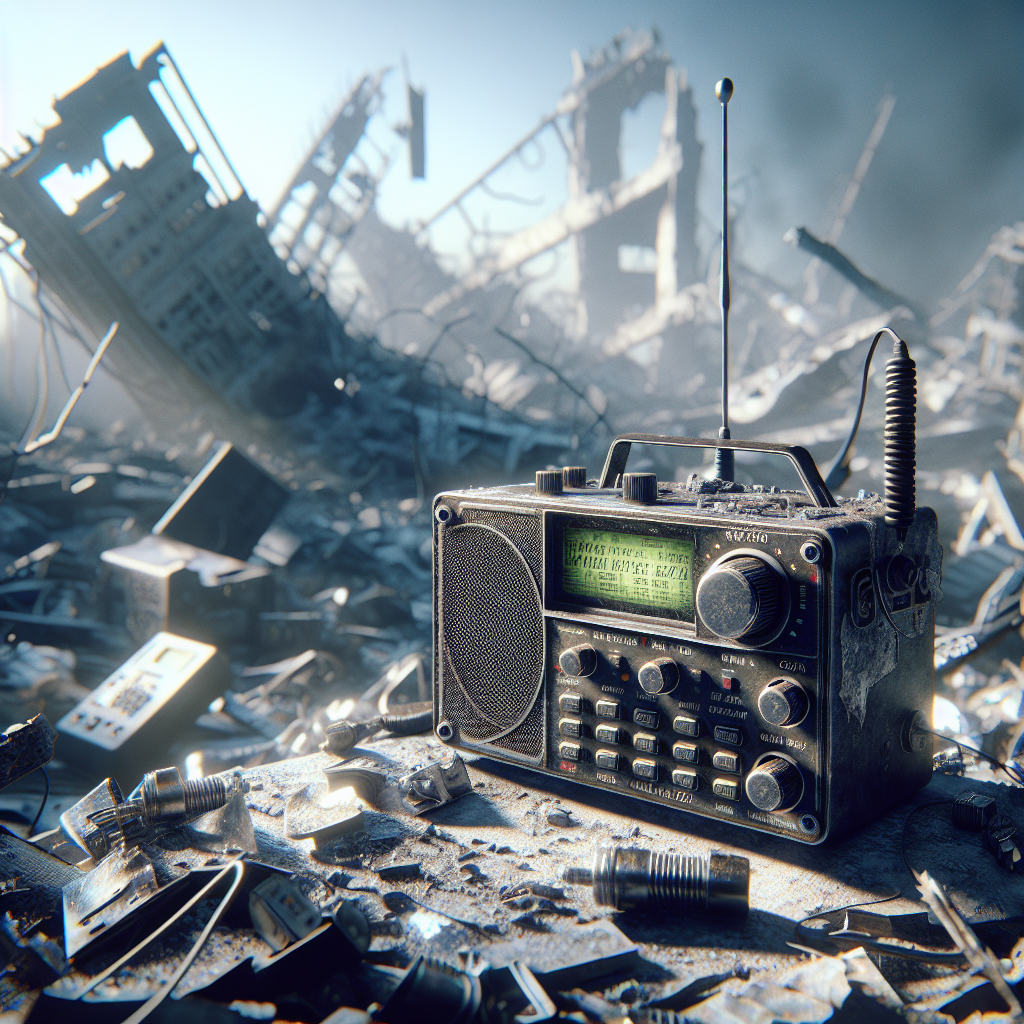In times of crisis, communication is crucial. When faced with the aftermath of an electromagnetic pulse (EMP) event, traditional methods of communication, such as cell phones and the internet, might become obsolete. However, there is a tried and true alternative that can keep you connected with the outside world: ham radios. These powerful devices have long been used by amateur radio operators to communicate across vast distances, and in the face of an EMP, they can become a lifeline to vital information and assistance. In this article, we will explore the importance of emergency communication and the use of ham radios as a reliable means of staying connected in a post-EMP world.

Importance of Emergency Communication
In times of emergency, communication is absolutely critical. It is essential for coordinating rescue efforts, providing vital information to the community, and ensuring the safety and well-being of individuals. However, when faced with a catastrophic event such as an electromagnetic pulse (EMP) that disrupts traditional communication systems, alternative methods must be utilized. This is where ham radios, also known as amateur radios, come into play. These versatile devices can be a lifeline during an emergency, allowing you to stay connected with others and obtain help when it is needed the most.
Introduction to Ham Radios
Ham radios are a type of two-way radio communication equipment that enables individuals to communicate with each other over long distances using shortwave frequencies. These radios are commonly used by amateur radio operators, also known as hams, who have obtained the necessary licenses and certifications to operate them legally. Ham radios have been used for decades as a reliable means of communication, particularly during emergencies and disaster situations where normal communication channels may be compromised or unavailable.
Understanding EMP and its Impact on Communication Systems
To fully appreciate the importance of ham radios in emergency situations, it is crucial to understand what an electromagnetic pulse (EMP) is and how it can impact communication systems. An EMP is a burst of electromagnetic radiation that can be caused by high-altitude nuclear explosions, solar storms, or certain man-made devices. This burst of energy can disrupt or damage electronic devices and infrastructure, including power grids, communication networks, and even the microprocessors inside modern devices.
During an EMP event, traditional communication systems such as cellular networks, landline phones, and the internet may cease to function. This can leave individuals and communities cut off from vital information and lifelines. However, ham radios are designed to operate independently of these infrastructure-dependent systems, making them an invaluable tool for emergency communication.
Why Ham Radios are Effective After an EMP
Ham radios possess several key features that make them highly effective for emergency communication after an EMP event. Firstly, they operate using low-power transmitters and receivers, allowing for greater energy efficiency and increased battery life. This is particularly advantageous during a post-EMP scenario where access to electricity may be limited or non-existent.
Additionally, ham radios utilize a vast array of frequencies, including shortwave bands that can travel long distances even without the support of communication towers and infrastructure. These frequencies can penetrate obstacles such as buildings, mountains, and dense forests, ensuring that you can maintain reliable communication over significant distances, regardless of the terrain.
Moreover, ham radios often have built-in capabilities for transmitting and receiving digital signals, enabling the exchange of data such as text messages, emails, and even images. This can prove invaluable for sharing vital information, maps, and emergency instructions during a crisis.

Preparing for an EMP Event
While the possibility of an EMP event may seem daunting, preparedness is key to overcoming such challenges. Building a comprehensive emergency plan that includes ham radio communication is a crucial step in readiness. Start by educating yourself and your community about the risks and impacts of an EMP event. Understanding the potential consequences can help motivate you to take the necessary precautions.
Creating an emergency kit that includes essential supplies such as food, water, first aid, flashlights, and extra batteries is also vital. In this kit, be sure to include a portable ham radio and spare batteries. Additionally, it is essential to have a backup power source, such as a solar charger or a hand-crank generator, to keep your ham radio operational.
Choosing the Right Ham Radio Equipment
Selecting the appropriate ham radio equipment can significantly impact your ability to communicate effectively in an emergency. When choosing a ham radio, consider factors such as frequency range, power output, durability, and ease of use. Portable handheld models are excellent choices as they provide mobility and can be easily carried during evacuation or rescue situations.
It is also essential to have a reliable antenna system to enhance the range and quality of your communication. A good antenna can help you overcome obstacles and maximize the efficiency of your ham radio. Consider investing in a portable or multi-band antenna that can be easily deployed in various scenarios.
Furthermore, acquiring a few spare parts and accessories such as extra cables, connectors, and batteries can prove beneficial during extended emergency situations. Being prepared with backup equipment ensures that you can continue to communicate even if your primary radio or accessories experience technical issues.
Setting Up a Ham Radio Station
Setting up a ham radio station requires careful planning and consideration. Identify a suitable location for your station, preferably an area with minimal interference from surrounding structures or electrical equipment. A quiet location away from power lines and electronic devices will help reduce background noise and interference, allowing for clearer reception and transmission.
Ensure that your station has a stable power source, such as a battery bank or a generator, to keep your ham radio operational during extended emergency situations. Establish proper grounding and protection against power surges to safeguard your equipment and minimize the risk of damage caused by unexpected power fluctuations.
Finally, become familiar with the operation and features of your ham radio equipment. Practice setting up and operating your station to ensure that you are comfortable and proficient in its use. Familiarity and confidence in using your ham radio will be invaluable during times of stress and urgency.
Operating a Ham Radio After an EMP
When an EMP event occurs, it is important to implement specific procedures to ensure the effective operation of your ham radio. Start by assessing the condition of your equipment and power supply, checking for any damage caused by the electromagnetic pulse. If there are no visible signs of damage, proceed to power on your equipment and establish communication with others in your network.
During an EMP event, it is essential to conserve power and use your ham radio sparingly. Limit unnecessary transmissions and prioritize essential communications. Keep your messages concise, clear, and focus on conveying critical information. By practicing good radio discipline, you can optimize the efficiency and effectiveness of your communication, conserving precious battery life and ensuring that your messages are received and understood.
Amateur Radio Licenses and Regulations
Before operating a ham radio, it is crucial to obtain the necessary licenses and certifications. The Federal Communications Commission (FCC) in the United States regulates amateur radio operations and issues licenses to individuals who pass the required examinations. These licenses ensure that operators have the necessary knowledge and skills to operate ham radios safely and responsibly.
To acquire a license, individuals need to study and pass the Technician Class examination, which covers basic operating procedures, rules, and regulations. Once licensed, operators are assigned a unique call sign, which serves as their identifier when communicating with other amateur radio operators. It is important to familiarize yourself with the specific licensing requirements and regulations in your country or region.
Additional Tips and Considerations
In addition to the basic information covered so far, there are a few additional tips and considerations to keep in mind when using ham radios after an EMP event. Firstly, make an effort to establish connections and networks with other amateur radio operators in your local area. By building relationships and practicing communication exercises, you can enhance your ability to coordinate and collaborate during emergencies.
Regularly testing and maintaining your ham radio equipment is essential. Conduct periodic checks to ensure that your equipment is in good working order, and perform practice drills to keep your skills sharp. Regular maintenance and practice will help you identify any issues or limitations in advance, allowing you to address them before an emergency occurs.
Lastly, it is important to continuously educate yourself about emergency communication best practices and advancements in ham radio technology. Stay updated on the latest techniques, frequencies, and equipment that can enhance your emergency communication capabilities. Attend workshops, join amateur radio clubs, and participate in training exercises to broaden your knowledge and skills in this vital field.
In conclusion, ham radios are indispensable tools for emergency communication after an EMP event. Their unique features, reliability, and independence from traditional communication infrastructure make them an invaluable asset when other systems fail. By preparing in advance, choosing the right equipment, and becoming proficient in operating ham radios, you can effectively communicate, coordinate, and obtain assistance during times of crisis. Remember, being proactive and knowledgeable about emergency communication can be the difference between survival and vulnerability. Stay prepared, stay connected, and stay safe.






